#tamil calendar
Explore tagged Tumblr posts
Text
தேதி: 31.01.2023. நாள்: செவ்வாய்க்கிழமை
மேலும் படிக்க » https://www.todaynallaneram.com/2023/01/31-january-tuesday.html
#tamil calendar#today nalla neram#today rasi palan#today horoscope#today is my birthday#calendar 2023#2023
0 notes
Text
The Nagarathar Way: Portrait of a community
The diary is dog-eared and gravy-stained, fraying at the edges, its pages sepia. The old grandfather clock in the foyer stands sentinel over the Burma teak staircase that creaks with the weight of history. A page from Umayal Palaniappan’s diary | Photo Credit: R RAVINDRAN Umayal Palaniappan leafs through the diary, strangely yearless, drawing attention to the recipes written in a neat hand, in…
View On WordPress
#Aachi#Aavani Gnayiru Pongal#Aippasi Mudhal Muzhukku#art deco#Burma#Ceylon#chettinad#Clare Arni#Kalkandu vadai#Kolam#Malaya#Murano#Nagarathar#Nattukottai Chettiar#Palladian#Selvaprakash Lakshmanan#singapore#Spastics Society of Tamil Nadu#Tamil Calendar#The Nagarathar Way#Umayal Palaniappan#world war ii
0 notes
Text
Check Out All The Shubha Muhurtham - Tamil Wedding Dates 2024 Has In Store For You. Stay Tuned To ShaadiWish For Latest Trends And Ideas.
#2024 Marriage Dates For Tamil Couples#2024 Wedding Dates#Dates For Tamil Wedding 2024#Hindu wedding dates#Marriage Dates For Tamil Couples#Tamil Calendar 2024 Muhurtham Dates#Tamil Dates#Tamil Marriage Dates For 2024#Tamil Muhurtham Dates 2024#Tamil Wedding#Tamil Wedding Calendar 2024#tamil wedding dates#Tamil Wedding Dates 2024#Tamil Wedding Muhurat 2024#Valarpirai Muhurtham Dates 2024#wedding dates#Wedding Dates For 2024#Wedding Planning#wedding plans#wedding season#shaadiwish
0 notes
Text
#aadi perukku 2023 date#aadi perukku 2023#aadi perukku 2023 in tamil#aadi 2023 tamil calendar#aadi month 2023
0 notes
Text

Happy new year!... Again
Bonus Akechi because I forgot the baby I'm sorry

Akechi's yapping under the cut.
The New Year is the time or day at which a new calendar year begins and the calendar's year count increments by one. Many cultures celebrate the event in some manner.In the Gregorian calendar, the most widely used calendar system today, New Year occurs on January 1 (New Year's Day, preceded by New Year's Eve). This was also the first day of the year in the original Julian calendar and the Roman calendar (after 153 BC). Other cultures observe their traditional or religious New Year's Day according to their own customs, typically (though not invariably) because they use a lunar calendar or a lunisolar calendar. Chinese New Year, the Islamic New Year, Tamil New Year (Puthandu), and the Jewish New Year are among well-known examples. India, Nepal, and other countries also celebrate New Year on dates according to their own calendars that are movable in the Gregorian calendar.
An example of another new year is Chunyipai Losar, the traditional day of offering ( Dzongkha: buelwa phuewi nyim) in Bhutan. It is observed on the 1st day of the last month of the Butanese lunar calendar. This means it usually takes place in January or February in the western calendar.And this year falls on 12th of January. Some people claim that residents of Bhutan made their annual offering of grains to Zhapdrung Ngakwang Namgyel in Punakha on this day. The Trongsa Penlop is said to have led the representatives of eight eastern regions in their offerings, as the Paro Penlop coordinated the people of western Bhutan and the Darkar Ponlop oversaw the people of the south. In this regard, some people place a great significance on this New Year as a marker of Bhutan’s sovereignty and solidarity. However, some scholars contest that no clear evidence of such practice exists. In any case, many feel that before Zhabdrung Ngawang Namgyal’s unified Bhutan as a state, the local population in some of Bhutan’s valleys celebrated this day as a New Year. As a result, even the government instituted by Zhabdrung in the 17th century, then largely a monastic court, saw this time as an important part of the year. The retirement and appointment of high officials in the government and the monastic body took place mainly during this New Year celebration.This New Year is primarily observed in eastern Bhutan, where it also referred to as Sharchokpé Losar, or New Year of the eastern Bhutanese. However, the observance of this New Year is not limited to eastern Bhutan and today with easy communication facilities, migration of people and intermarriages between various regions of Bhutan, people all over Bhutan observe this New Year. Like other Bhutanese seasonal festivals marking a new season, the Chunyipai Losar falls around the Winter Solstice. It also falls after the agricultural work for one season is completed and before the new harvest cycle begins. Thus, it is a seasonal celebration which is aligned well with the agrarian populace.
At the end of the day this is all inane information that the artist is using to justify the fact that they are posting this drawing 12 days late and as a means to share their culture despite the fact that the artist themselves are very out of touch with thier culture and in fact forgot that it was chunyipi losar until they were reminded by thier family and did little to observe or celebrate the day outside of baking a cake with a concerningly large amount of butter.
#i love you touma#never shut up#the disaster of psi kusuo saiki#the disastrous life of saiki k.#saiki no psi nan#saiki k#saiki kusou no psi nan#kusuo saiki#saiki fanart#toritsuka reita#aiura mikoto#touma akechi#pk psychickers#I love you touma i love you#sorry hes my precious little silly guy#i cant believe i forgot him#oh oop made a typo its fixed now
243 notes
·
View notes
Text
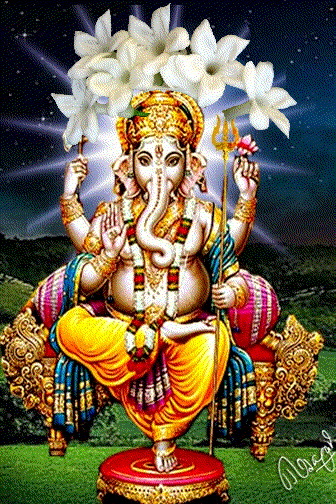
🌺Om Gam Ganapataye Namaha🌺
Happy New Year!
Gregorian Calendar: Janus Portal January 1, 2024 — an 8 year is a Saturnian number.
Chinese New Year: February 10, (2024) /Chinese Calendar Year 4722 — a number 6 year. Wood Dragon.
Tamil New Year: April 14 (2024) /Tamil Calendar Year 5126 Kaliyuga.

32 notes
·
View notes
Text
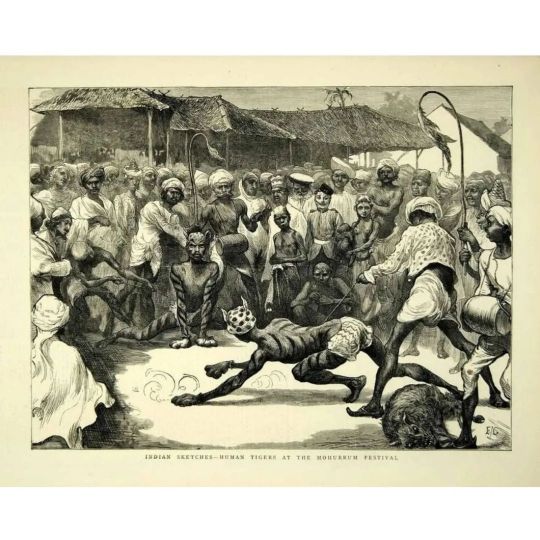
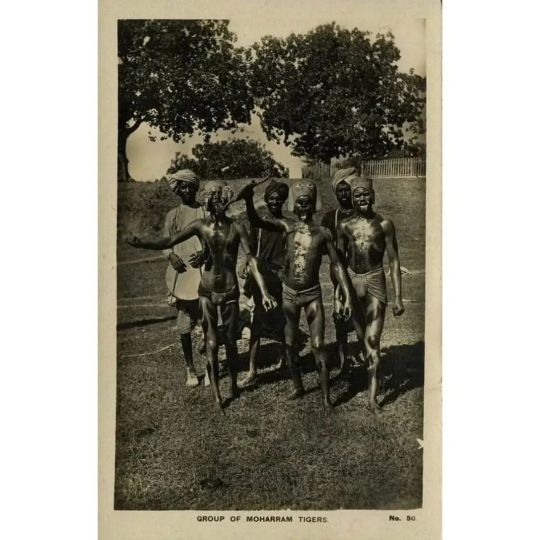


"During the month of Muharram - the first month of the Islamic calendar - in regions of Central and South India, people dress up as tigers as part of a cultural practice that goes back centuries. They wear masks, paint tiger stripes on their bodies, and move and act like a tiger. There is even a "tiger dance." Some sources say that, within the context of Muharram, the purpose of imitating a tiger is to show that Imam Hussein’s bravery and strength can be comparable to that of a tiger. (During Muharram, Shia Muslims mourn the death and sacrifice of the grandson of Prophet Muhammad, Imam Hussein ibn Ali, in the battle of Kerbala).
This practice of imitating tigers is also seen in other rituals in different regions of India, such as in Kerala, where people are dressed as tigers to celebrate the harvest each year. It's known as Puli kali (tiger dance). In Tamil Nadu, it's known as Puliyattam. In Andhra Pradesh, it's called Pulivesham.
It is unclear where the cultural practice of imitating tigers began from and how it spread and blended into different communities around India."
#muharram#islam#religion#history#india#puli kali#Puliyattam#Pulivesham#dance#tigers#syncretism#harvest#hinduism#culture
24 notes
·
View notes
Text
Today in Christian History

Today is Friday, February 23rd, 2024. It is the 54th day of the year in the Gregorian calendar; Because it is a leap year, 312 days remain until the end of the year.
1680: Death of Thomas Goodwin (pictured above), a notable English Congregational Nonconformist preacher. He had been a member of the Westminster Assembly of 1650, and author of many biblical and theological works. His last words were: “Ah, is this dying? How I have dreaded as an enemy this smiling friend.”
1719: Death in Tranquebar, India, of thirty-six-year-old Bartholomew Ziegenbalg, missionary to India, who has established a seminary, translated the New Testament into Tamil, converted and baptized over two hundred Indians, and constructed a church building. At one point he had been imprisoned by the Dutch who feared his preaching would antagonize the Hindus they administered.
1758: Jonathan Edwards receives a smallpox vaccination from which he contracts the disease. He will die in March.
1819: A new church at Friedensthal on St. Croix Island is consecrated to the worship of the living God by Moravians and their converts. The congregation is so numerous not a third part can get inside the doors.
1846: Following the outrage raised by his publication of “Remarks on Certain Passages in the Thirty-Nine Articles,” in which he has tried to reconcile Church of England teaching with Roman positions, and his migration to the Roman Catholic church, John Henry Newman leaves Oxford for good.
1855: John Bright, a Quaker-born Christian parliamentarian in England, makes an eloquent speech against the Crimean War. Its most famous line is, the “Angel of Death has Been Abroad.”
1918: The body of the Orthodox priest George Porgachevsky is found about a mile and a quarter from the village of Ivanovskoye, Amur region. His head is crushed and he has two bayonet wounds in his stomach. The Soviets had arrested him thirteen days earlier.
1925: Death in Alexandria, Virginia, of Kate Waller Barrett, an American physician, who, as a single mother and member of the Episcopal Church, co-founded the National Florence Crittenton Mission financed by wealthy Charles Nelson Crittenton. She had secured for the mission the first-ever federal charter for a charitable organization.
1929: Lindel Tsen is consecrated as Assistant Bishop of Honan, the first Chinese bishop in an established Anglican diocese. He will become the principal leader of Chinese Anglicanism in the mid-20th century and suffer persecution at the hands of the government.
1934: Death in Baltimore, Maryland, of Peter Ainslie, a Disciples of Christ minister, ecumenical leader, and author of The Scandal of Christianity, a sharp rebuke of divisions among Christians.
1951: Death of Zhang Boling (Chang Po-ling), a prominent Chinese Protestant layman and educator. He had been affiliated with the YMCA, founded Nankai University, accepted women for education, and promoted athletic activities. Because of the school’s patriotism the Japanese had bombed and burned it and succeeding political changes made him unwelcome.
6 notes
·
View notes
Text
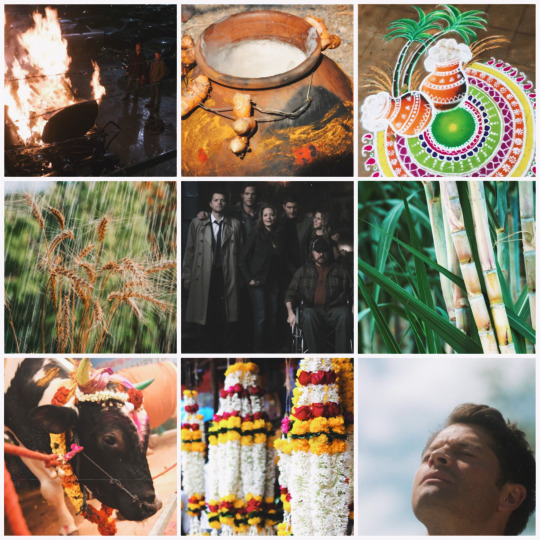
spn pongal moodboard for @spnpocdirectory's cultural exchange event day 4: traditions/festivals explanation of pongal below cut:
Pongal (பொங்கல்), or Thai Pongal (தைப்பொங்கல்), is a Hindu harvest festival celebrated by Indian and Sri Lankan Tamils every year around mid-January (it follows the Tamil solar calendar).
There are officially four days of Pongal but most people only celebrate three or less (personally I only celebrate the second day and a little of the first day because Pongal is not easy to celebrate in urban areas/countries).
The Four Days:

Day 1: Bhogi Pongal (idk what exactly bhogi means I'm sorry)
Bhogi Pongal is about starting anew because it is the last day Marghali month according to the Tamil calendar. People celebrate by wearing new clothes, cleaning their houses, and discarding old possessions. And they discard their old things by gathering around a bonfire and burning everything 👍 (reason for choosing the pic of Sam and Dean standing by a bonfire).

Day 2: Surya Pongal (Surya = Sun)
Surya Pongal is the main day of the festival and the first day of the Thai month. This day is dedicated to the sun god (reason for choosing the pic of Cas looking at the sun). To celebrate this day we make the pongal dish in a decorated pot as seen in the second image. Traditionally, the pongal dish is prepared outdoors and as a group. So the pot is placed over a fire and milk is added in. Once it starts to boil, freshly harvested rice and cane sugar are added. Eventually the pot will start to overflow and when this happens everyone will shout "Pongalo Pongal" which translates to "may this rice boil over. In urban areas its typically just one or a few people making the dish in the kitchen on the stove. We also decorate our doorsteps with kolam (which is depicted in the third image)

Day 3: Mattu Pongal (Mattu = Cow)
Mattu Pongal is a day where we worship the cattle because they are sacred animals in the Hindu religion. The cattle are adorned with flower garlands (as seen in pictures 7 and 8) and their horns are painted. The cows basically get special treatment that day like being fed pongal and other natural sweet treats and are bathed.

Day 4: Kanum Pongal (Kanum = to visit)
Kanum pongal is about reunion and visiting family and friends (which is why I chose the middle picture)
#supernatural#spn#pocnatural#desinatural#pocnaturalculturalexchange#tamilnatural#trees photo edits and misc
44 notes
·
View notes
Note
🦋 If you get this, answer with 3 random facts about yourself and send it to the last 7 blogs in your notifications, anonymously or not! Let's get to know the person behind the blog 🦋
Hi! Thanks for the ask! Ok so,
my first time seriously drawing was in 2020; I was doing online classes and it was around 9: 30. It was a drawing of a realistic eye and it took me forty five minutes. my drawing has gotten better(and worse) in many ways since then, but it's still one of my favorite things I've ever drawn. mostly because 2020 was a shitty year and discovering drawing as an outlet was almost magical.
y'all remember harrypotterfanfiction? ok so when i was 12 I wrote the cringiest ff on there about this spy oc named cassandra who- you guessed it- was a teacher at hogwarts, had a mYsTeRiOuS pAsT and was besties with the malfoys and had weird tension shit going on with snape. I got as far as the scene where snape died, dramatically in casssandra's arms(he was supposed to come back to life two chapters later) but then I decided it was too boring and never came back to it. took it down because sanity returned to me.
i was born under the pleiades star. its called krithika nakshatram in tamil, and I'm tamil. idk why this was so important to 10 year old me, but I wrote it down in all of those bio things that came with notebooks/agendas/calendars. so i think it's worth mentioning.
So... yeah. I think you can't get more random than that, and though I think these are more anecdotes than everything, eh. Tagging the 7 blogs because leaving an ask is still very confusing.
@horror-lover17 , @v1cv1c , @angrynerdpartydonut , @trinikins , @inc0rrect , @nellietrelawney , @shortqueershakespeare
31 notes
·
View notes
Text
List of gender neutral/non binary names from mythology! (global mythology) (Part 1!)
Hope this helps someone! (Added some relative links/definitions from 'Behind the Name'. :D)
If you have any suggestions of what I should post next feel free to send me an ask!! :D
Ailbhe (Irish): From Old Irish Ailbe, possibly derived from the old Celtic root *albiyo- "world, light, white" or Old Irish ail "rock". In Irish legend this was the name of a female warrior of the Fianna. It was also the name of a 6th-century masculine saint, the founder of a monastery at Emly.
Ailbe (Old Irish): Old Irish form of Ailbhe.
Ananta (Hinduisim): Means "infinite, endless" in Sanskrit. This is a transcription of both the masculine form अनन्त / अनंत (an epithet of the Hindu god Vishnu) and the feminine form अनन्ता / अनंता (an epithet of the goddess Parvati).
Aruna (Hinduism, Indian, Telugu, Tamil, Kannada, Malayalam, Hindi): Means "reddish brown, dawn" in Sanskrit. The Hindu god Aruna (अरुण) is the charioteer who drives the sun god Surya across the sky. The modern feminine form अरुणा is also transcribed as Aruna, however the modern masculine form is Arun.
Bala (Hinduisim, Tamil): Means "young" in Sanskrit. This is a transcription of both the masculine form बाल and the feminine form बाला (a minor Hindu goddess).
Chanda (Hinduism, Indian, Hindi): Means "fierce, hot, passionate" in Sanskrit. This is a transcription of both the masculine form चण्ड and the feminine form चण्डा (an epithet of the Hindu goddess Durga).
Chandra (Hinduism, Bengali, Indian, Assamese, Hindi, Marathi, Telugu, Tamil, Kannada, Nepali): Means "moon" in Sanskrit, derived from चन्द (chand) meaning "to shine". This is a transcription of the masculine form चण्ड (a name of the moon in Hindu texts, which is often personified as a deity) as well as the feminine form चण्डा.
Fedelmid (Old Irish): Variant of Feidlimid.
Fedlimid (Old Irish) Variant of Feidlimid.
Feidlimid (Old Irish): Traditionally said to mean "ever good", it might be related to Old Irish feidil "enduring, constant". This was the name of three early kings of Munster. It was also borne by a 6th-century saint, typically called Saint Felim. In Irish legend, it was the name of the father of Deirdre.
Hordad (Persian): Middle Persian form of Haurvatat.
Inari (Japanese): Means "carrying rice" in Japanese, from 稲 (ina) meaning "rice" and 荷 (ri) meaning "carry". This is the name of a Japanese divinity associated with prosperity, rice and foxes, represented as both female and male.
Jaya (Hinduism, Tamil, Indian, Telugu, Hindi, Marathi): Derived from Sanskrit जय (jaya) meaning "victory". This is a transcription of both the feminine form जया (an epithet of the Hindu goddess Durga) and the masculine form जय (borne by several characters in Hindu texts). As a modern personal name, this transcription is both feminine and masculine in southern India, but typically only feminine in the north.
Kamala (Hinduism, Tamil, Indian, Kannada, Telugu, Hindi, Nepali): Means "lotus" or "pale red" in Sanskrit. In Sanskrit this is a transcription of both the feminine form कमला and the masculine form कमल, though in modern languages it is only a feminine form. This is the name of one of the Krittikas, or Pleiades, in the Hindu epic the Mahabharata. It is also another name of the Hindu goddess Lakshmi.
Khordad (Persian): Modern Persian form of Haurvatat. From the Middle Persian era, this deity was often considered masculine. The third month of the Iranian calendar is named for her.
Khurshid (Persian, Urdu): Modern Persian form of Avestan (Huuarə Xshaēta) meaning "shining sun". In Zoroastrianism this was the name of a Yazata (a holy being) who was associated with the sun.
Metztli (Aztec, Toltec, Indigenous American, Nahuatl): Means "moon" in Nahuatl. This was the name of the Aztec god (or goddess) of the moon.
Meztli (Aztec, Toltec, Indigenous American, Nahuatl): Variant of Metztli.
Mitra (Hinduism, Indian, Hindi): Means "friend" in Sanskrit, a cognate of Mithra. This is a transcription of both the feminine form मित्रा and the masculine form मित्र, which is the name of a Hindu god of friendship and contracts who appears in the Rigveda.
#nonbinary#gender netural#non binary names#gender netural names#hindu mythology#irish mythology#name ideas
20 notes
·
View notes
Note
Re: the men in black quote - I think you misinterpreted what the point was haha, the guy said that in response to will smith's character going "wait you're telling me aliens are real? that's not true!" bc everyone thinks what they know is the sole factual truth until it inevitably gets disproved. so people once "knew" the earth being flat is The Truth, until scientists discovered otherwise - who knows what other supposed objective truths of our time will be disproven hundreds of years from now?

great news, you absolutely misinterpreted what I meant.
let's review: the quote in question is, "fifteen hundred years ago everybody knew the earth was the center of the universe. five hundred years ago, everybody knew the earth was flat, and fifteen minutes ago, you knew that humans were alone on this planet. imagine what you'll know tomorrow."
my tags: #congenital defect to be the funsucker but those first two are obviously and patently untrue. still a fun quote
my meaning: neither of these statements are true because 1500 and 500 years ago, many, many people knew and had known that the earth was not the centre of the universe and that the earth was not flat, respectively.
explanation point A: 1500 years ago puts us at 523 AD.
the first non-geocentric (as in earth is the centre of the universe) model was proposed by Philolaus who died in 390 BC.
the first heliocentric model was proposed Aristarchus of Samos, who lived circa 290 BC.
The classic Tamil work Ciṟupāṇāṟṟuppaṭai from the 3rd-5th century AD by Nattattaṉār is so head in the game that it uses "the sun being orbited by planets" as a metaphor. so people had already, for hundreds of years, known that the earth was not the centre of the universe.
I can kind of see the point on this because the heliocentric model had undergone periods of acceptance and then got shot in the foot with the publication of the Almagest and wouldn't come back into vogue for some time. my point is that plenty of people had already known that the earth wasn't the centre of the universe.
explanation point B: 500 years ago puts us at 1523 AD.
there is no explanation for this. it's straight up lazy writing and historical revisionism and also believing popular and dumb myths.
our main man Pythagoras (6th century BC) proposed a spherical earth. This was followed up by a spherical earth model from no one's main man Aristotle (330 BC). Ptolemy (2nd century AD) made his maps from a globe.
the 5th century AD Indian astronomer Aryabhata (who also had some stuff going with the heliocentric solar system model! crazy!) assumed a spherical earth model in quantitative astronomy models for developing a calendar.
Persian baddie Fakhruddin Razi (1150 – 1209) explicitly said "...because the Earth, even though it is round, is an enormous sphere, and each little part of this enormous sphere, when it is looked at, appears to be flat."
getting closer to the present, Thomas Aquinas (1225–1274) assumed a spherical earth model and that everyone KNEW that the earth was spherical.
for the hat trick, Ferdinand Magellan started his circumnavigation of the earth in 1519 and the ship came back in 1522, almost exactly 500 years ago! fucking Christopher Columbus knew the earth was a sphere!
which is to say: girl, they been knowing that!!! where the fuck have you been that you've been listening to Washington Irving about the idea that medieval (European) people thought that the earth was flat?
explanation point C: there are, effectively, no beliefs that have ever been so agreed on by all of humanity that we can say "everyone" "knew" it. ancient India had atheism. atom theory goes back to ancient Greece. there are plenty of examples of matrilineal and matriarchal societies that actually valued women as people. Thucydides, Lucretius, and Marcus Terentius Varro all had an idea of diseases being spread from an infected person to a healthy person ("there are bred certain minute creatures which cannot be seen by the eyes, which float in the air and enter the body through the mouth and nose and there cause serious diseases"). I point this out because I am a chronic funsucker who loves to nitpick, as I am doing now.
explanation point D: if you think I'm too stupid to understand this incredibly basic and historical oversimplifying ass quote, unfollow me.
#'people once “knew” the earth being flat is The Truth until scientists discovered otherwise' like you must be joking. please.#Egg talks#people love to imagine a woman so stupid#all of this information is from Wikipedia by the way you can cite all of this
6 notes
·
View notes
Text
Navratri is a nine-night Hindu festival celebrating the goddess Durga It involves fasting, feasting. 🌟 Happy Navratri! 🌟
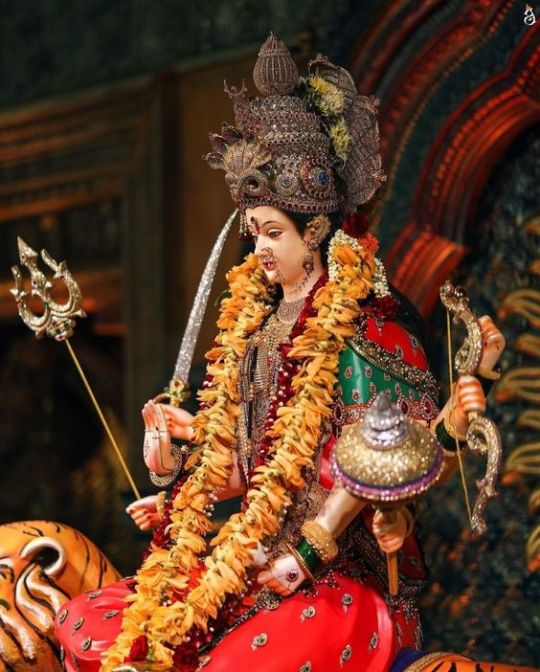
Navratri is a vibrant Hindu festival celebrated with great fervor and enthusiasm across India and by Hindus around the world. The word 'Navratri' literally translates to "nine nights" in Sanskrit, and the festival spans nine nights and ten days, dedicated to the worship of the Hindu goddess Durga and her various forms. Navratri typically falls in the Hindu lunar month of Ashvin , which usually corresponds to September or October in the Gregorian calendar.
Here are some key aspects and traditions associated with Navratri:
Worship of Goddess Durga: Navratri honors the divine feminine energy, particularly Goddess Durga, who symbolizes courage, power, and victory over evil. Each of the nine days is dedicated to one of her different forms, known as Navadurga. These forms include Shailaputri, Brahmacharini, Chandraghanta, Kushmanda, Skandamata, Katyayani, Kalaratri, Mahagauri, and Siddhidatri.
Fasting and Feasting: Fasting is a common practice during Navratri, where devotees abstain from consuming certain foods or have strict diets. Some may observe complete fasting, while others may abstain from specific food items like grains, onion, garlic, and non-vegetarian food. The fasts are believed to purify the body and mind and enhance spiritual practices. At the same time, special Navratri delicacies are prepared and shared among family and friends, including dishes like sabudana khichdi, kuttu ki puri, and singhare ka halwa, made with ingredients permissible during fasting.
Garba and Dandiya Raas: One of the highlights of Navratri celebrations is the vibrant and colorful Garba and Dandiya Raas dances. Garba involves circular formations where participants dance gracefully in traditional attire, often accompanied by devotional songs praising the goddess. Dandiya Raas, on the other hand, involves energetic and rhythmic dance performances with sticks (dandiyas) held in each hand, symbolizing the playful combat between Goddess Durga and the demon Mahishasura.
Golu or Bommai Kolu: In South India, particularly in Tamil Nadu and Karnataka, Navratri is celebrated through the tradition of Golu or Bommai Kolu. During this custom, dolls and figurines representing various deities and mythological characters are displayed on steps or shelves adorned with colorful decorations. Visitors are invited to homes to view the display, and it's considered auspicious to offer prayers and seek blessings during this time.
Vijayadashami: Navratri culminates on the tenth day with Vijayadashami or Dussehra, which marks the triumph of good over evil. This day is significant for various reasons, including the victory of Lord Rama over the demon king Ravana in the epic Ramayana. In many parts of India, effigies of Ravana, Megh nath, and Kum bhakarna are burnt to symbolize the victory of righteousness.
#hindu festival#festival navratri#festival#festivegifts#festival Navratri#hindu gods#hinduism#mahadev#lord shiva#india#hindu sahiban nahi samjhe gita ved puran#Hindu festival
5 notes
·
View notes
Text
In the 1950s and ’60s, women baked cakes in the abandoned ammunition boxes left behind by British troops in the villages of Nagaland, a state in northeast India. The Naga writer Easterine Kire recalls how wives of Christian missionaries taught English and cake-baking to young girls, including her mother. While they didn’t really pick up the language, the tradition of baking cakes was passed down “from mother to daughter and from daughter to granddaughter.” It was the men who thought to repurpose the boxes — they were airtight, preserved heat well and fit perfectly over the wood fire. Since they had no temperature controls, the baker had to sit by the fire, constantly stoking it and eventually reducing it to embers. The timing had to be perfect: A minute too soon or too late could alter the fate of the cake. The boxes eventually ended up becoming part of a family’s heirloom until electric ovens became commonplace.
In the opposite corner of India, in Kerala in the deep south, several bakeries trace their history to the Mambally Royal Biscuit Factory in Thalassery, established in the late 19th century. Its founder, Mambally Bapu, is said to have baked India’s first Christmas cake. Bapu had trained as a baker in Burma (now Myanmar) to make cookies, bread and buns. When he set up shop in 1880, he made 140 varieties of biscuits. Three years later, the Scotsman Murdoch Brown, an East India Company spice planter, shared a sample of an imported Christmas plum pudding. Wanting to re-create this traditional recipe but unable to source French brandy, Bapu improvised with a local brew made from fermented cashew apples and bananas. He added some cocoa and — voila — the Indian Christmas cake was born.
The beauty of the Indian Christmas cake lies in its local variations. The Allahabadi version from north India features petha (candied ash gourd or white pumpkin) and ghee instead of butter, along with a generous helping of orange marmalade. Maharashtrians, in west India, add chironji, also known as cuddapah almonds. The black cake in Goa derives its color from a dark caramel sauce. In the south, in Kerala and Tamil Nadu, cashew nuts are added to the mix. The Indian version is “a close cousin” of British plum pudding, but it has no lard and is not steamed. “Indian Christians add a generous dose of hot spices such as nutmeg, cinnamon, cloves and shahi zeera (royal cumin seeds), roasted dry and then ground and added, also referred to as ‘cake masala,’” writes Jaya Bhattacharji Rose, an Indian publishing consultant, in “Indian Christmas,” an anthology of personal essays, poems, hymns and recipes.
“Our Christmas cakes reflect how India celebrates Christmas: with its own regional flair, its own flavor. Some elements are the same almost everywhere; others differ widely. What binds them together is that they are all, in their way, a celebration of the most exuberant festival in the Christian calendar,” writes Madhulika Liddle, co-editor of the anthology. Reading the book feels like a celebration in itself and makes one realize that Christians in India are as diverse as India, with Syrian Christians, Catholics, Baptists, Anglicans, Methodists, Lutherans and others. Though Christians make up just 2% of India’s population, this equates to some 28 million people.
Christianity came to India in waves. It is believed that Thomas the Apostle arrived in present-day Kerala in 52 BCE and built the first church. Syrian Christians believe he died in what is now Chennai in Tamil Nadu. San Thome Basilica stands where some of his remains were buried. Toward the end of the 15th century, the Portuguese explorer Vasco da Gama landed on Indian shores, followed by others, paving the way for Portuguese colonies in the region. Christian missionaries, who set up Western educational institutes, spread the religion further. The trend continued under the British Empire.
What is unique about India is the “indigenization of Christmas,” notes Liddle. It can be seen in the regional dishes prepared for Christmas feasts and celebrations. Duck curry with appams (rice pancakes) is popular in Kerala, while Nagaland prefers pork curries, rich with chilies and bamboo shoots. In Goa, dishes with Portuguese origins, such as sausage pulao, sorpotel and xacuti, adorn the tables. Biryanis, curries and shami kababs are devoured across north India.
The same regional diversity can be seen in Christmas snacks. “East Indians,” a Christian community in Mumbai described as such for their close ties to the East India Company, fill their plates with milk creams, mawa-filled karanjis (pastry puffs filled with dried whole milk), walnut fudge, guava cheese and kulkuls (sweet fried dough curls). In Goa, a platter of confectioneries called kuswar is served, including kormolas, gons, doce and bolinhas, made with ingredients ranging from coconut to Bengal gram, a yellow lentil. In Kerala, rose cookies are popular. Common across north Indian Christian households are shakkarpara, a sweet fried dough, covered in syrup; namakpara, a savory fried dough studded with cumin seeds; gujiyas, crisp pastries with a sweetened mix of semolina, raisins and nuts; and baajre ki tikiyas, thin patties made from pearl millet flour sweetened with jaggery, an unrefined sugar.
Liddle, who used to spend the festival at her ancestral home in the north Indian town of Saharanpur, also tells us about a lesser-known variation of the Christmas cake: cake ki roti. (In Hindi, “roti” means “flatbread.”) Like most communities in India, many Christian families in north India buy the ingredients for the Christmas cake themselves and take them to a baker who will prepare it. Bakers used to make the Christmas cake by the quintal (220 pounds) or more, and cake ki roti was a byproduct of that large-scale baking. The leftover Christmas cake batter was “not enough for an entire tin, not so little that it can be thrown away,” Liddle explained. So the baker would add flour and make a dough out of it. “It would be shaped into a large, flat disc and baked till it was golden and biscuity,” she said. The resulting cake ki roti may have “stray bits of orange peel or candied fruit, a tiny piece of nut here or there, a faint whiff of the spices … It was not even the ghost of the cake. A mere memory, a hint of Christmas cake.” Since cake ki roti was considered “too pedestrian,” it wasn’t served to the guests. Instead, it would be reserved until the New Year and eaten only after all the other snacks were gone.
Jerry Pinto, co-editor and contributor to “Indian Christmas,” recalled his childhood Christmases in Mumbai. There may not have been much snow in this tropical city, but wintry scenes of London and New York adorned festive cards and storybooks, and children would decorate the casuarina tree with cotton balls, assuming it to be pine. The mood would be set with an old Jim Reeves album featuring ��White Christmas.” “Where do old songs from the U.S. go to die? They go to Goan Roman Catholic homes and parties,” quipped Pinto. Raisins would be soaked in rum in October, and cakes baked at an Iranian bakery. Every year, there was a debate about whether marzipan should be made with or without almond skins. The “good stuff” meant milk creams and cake slices with luscious raisins, while rose cookies and the neoris (sweet dumplings made of maida or flour and stuffed with coconut, sugar, poppy seeds, cardamom and almonds) were just plate-fillers.
The feasting is accompanied by midnight mass, communal decorations and choral music, with carols sung in Punjabi, Tamil, Hindi, Munda, Khariya, Mizo tawng, as well as English. “One of our favorite carols was a Punjabi one, which we always sang with great gusto: ‘Ajj apna roop vataake / Aaya Eesa yaar saade paas’ [‘Today, having changed His form / Jesus comes to us, friend’],” Liddle remembered.
Starting as early as October, it would not be unusual to hear Christmas classics by Boney M., ABBA and Reeves in Nagaland’s Khyoubu village. “The post-harvest life of the villagers is usually a restful period, mostly spent in a recreational mood until the next cycle of agricultural activities begins in the new year,” wrote Veio Pou, who grew up in Nagaland.
“Christmas is a time when invitations are not needed. Friends can land … at each other’s homes any time on Christmas Eve to celebrate. … The nightly silence is broken, and the air rings with Christmas carols and soul, jazz and rock music. Nearly every fourth person in Shillong plays the guitar, so there’s always music, and since nearly everyone sings, it’s also a time to sing along, laugh and be merry,” wrote Patricia Mukhim, editor of Shillong Times, a local newspaper in the northeastern state of Meghalaya.
Neighborhoods in areas with Christian populations, like Goa and Kerala, are lit up weeks in advance with fairy lights, paper lanterns and Christmas stars. In Mizoram’s capital of Aizawl, local authorities hold a competition every Christmas for the best-decorated neighborhood, with a generous prize of 500,000 rupees ($6,000) awarded to the winner. This event is gradually becoming a tourist attraction.
Rural India has its own norms and traditions. In the villages of the Chhota Nagpur region, mango leaves, marigolds and paper streamers decorate homes, and locally available sal or mango trees are decorated instead of the traditional evergreen conifer. The editor Elizabeth Kuruvilla recalled that her mother had stars made of bamboo at her childhood home in Edathua, a village in Kerala’s Alappuzha district. The renowned Goan writer Damodar Mauzo, who grew up in a Hindu household, said his family participates in many aspects of the Christmas celebrations in the village, including hanging a star in the “balcao” (“balcony”), making a crib and attending midnight mass.
In the Anglo-Indian enclave of Bow Barracks in Kolkata, Santa Claus comes to the Christmas street party in a rickshaw — the common form of public transport in South Asia. “Kolkata’s Bengali and non-Bengali revelers now throng the street, lined by two rows of red-brick terrace apartment buildings, to witness the music and dance and to buy the home-brewed sweet wine and Christmas cake that some of the Anglo-Indian families residing there make,” wrote the journalist Nazes Afroz. Bow Barracks was built to house the Allied forces stationed in Kolkata during World War I, after which they were rented out to the city’s Christian families.
Kolkata also is home to a tiny community of about 100 Armenian Christians, who celebrate Christmas on Jan. 6, in line with the Armenian Apostolic Church. Many break their weeklong fast at the Christmas Eve dinner, known as “Khetum.” The celebration begins with an afternoon mass on Christmas Eve followed by a home blessing ceremony to protect people from misfortune, held at the Armenian College and Philanthropic Society, an important institution for the community. The Khetum arranged for the staff members and students includes a customary pilaf with raisins and fish and anoush abour, an Armenian Christmas pudding made with wheat, berries and dried apricots, among other dishes. The Christmas lunch also includes traditional Armenian dishes such as dolma (ground meat and spices stuffed into grape leaves) and harissa, a porridge-like stew made with chicken, served with a garnish of butter and sprinkled ground cumin.
“Missionaries to Indian shores, whether St. Thomas or later evangelists from Portugal, France, Britain or wherever, brought us the religion; we adopted the faith but reserved for ourselves the right to decide how we’d celebrate its festivals,” Liddle wrote. “We translated the Bible into our languages. We translated their hymns and composed many of our own. We built churches which we at times decorated in our own much-loved ways.”
44 notes
·
View notes
Photo
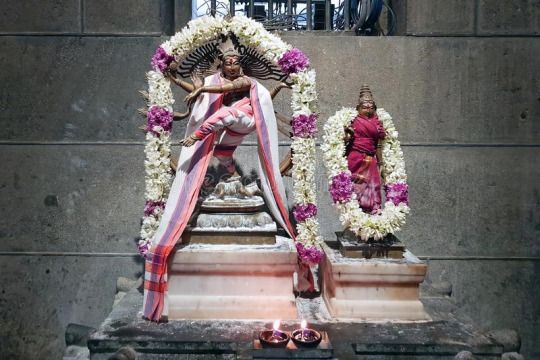
Sri Ramanasramam - The Matrubhuteswara Temple - Lord Siva dances in the form of Nataraja in front of the Mother, Sakti Devi
Arudra Darshanam is celebrated on the full moon night of Margazhi month of Tamil Calendar. This is observed on the thiruvadhirai nakshaththram (star) falling in this month.The festival marks the day of cosmic dance of Lord Shiva and it is celebrated in the form of Lord Nataraja. In Sri Ramanasramam, it is also celebrated in a grand manner. At around 4 am in 6 January 2023, the Nataraja idol in the Mathrubutheswara temple was anointed and decorated with flowers. This was followed by chanting of verses in praise of Nataraja followed by Aarthi...
******
Śrī Aruṇācala Navamaṇimālai - The Necklace of Nine Gems for Arunachala, Verse 1
🕉️
acalaṉē yāyiṉu maccavai taṉṉi lacalaiyā mammaiyedi rāḍu — macala vuruvilac catti yoḍuṅgiḍa vōṅgu maruṇā calameṉ ḏṟaṟi.
Padacchēdam (words rearranged in natural prose order): acalaṉē āyiṉum, a-c-savai taṉṉil acalai ām ammai edir āḍum. acala uruvil a-c-satti oḍuṅgiḍa, ōṅgum aruṇācalam eṉḏṟu aṟi.
English translation:
Though actually one who is motionless, in that assembly hall he dances opposite mother, who is acalā. Know that when that śakti subsides back in the motionless form, Aruṇācalam is exalted.
Explanatory paraphrase:
Though [Lord Siva is] actually acalaṉ [one who is motionless, being the one immutable ground from which and in which everything else appears], in that assembly hall [of Cidambaram] he dances [in the form of Nataraja] opposite [the divine] mother, who is acalā [the consort of acalaṉ]. Know that when that śakti [the divine mother] subsides back in the motionless form [the fundamental form of Lord Siva], Aruṇācalam is exalted [that is, in the motionless form of Aruṇācalam, which rises high above all his other forms, Lord Siva shines exalted in his natural state].
Note :
The word Achalan means the motionless one and is a name of Lord Siva which is used to denote the fact that He is the immutable, Supreme Reality. The word Achalai means the consort of Achalan and is a name of Sakti, the Divine Mother.
Though He is motionless by nature, in Chidambaram Lord Siva had to dance in front of Sakti in order to bring Her frenzied dance to an end. But in the form of Arunachala Lord Siva remains ever motionless, and thus by the power of His mere stillness Sakti was irresistably attracted to Him and with great love she subsided in Him and became one with Him. Hence of all the forms of Lord Siva, Arunachala shines as the most exalted.
The words ‘ongum Arunachalam’ means ‘rises high’ or rises above others, and hence the words ‘ongum Arunachalam endru ari’ (know that He shines exalted as Arunachala) may also be taken to mean, know that Arunachala is superior (to Chidambaram)!
Source: Sri Arunachala Stuti Panchakam - Meaning: Sri Sadhu Om - Translation: Michael James
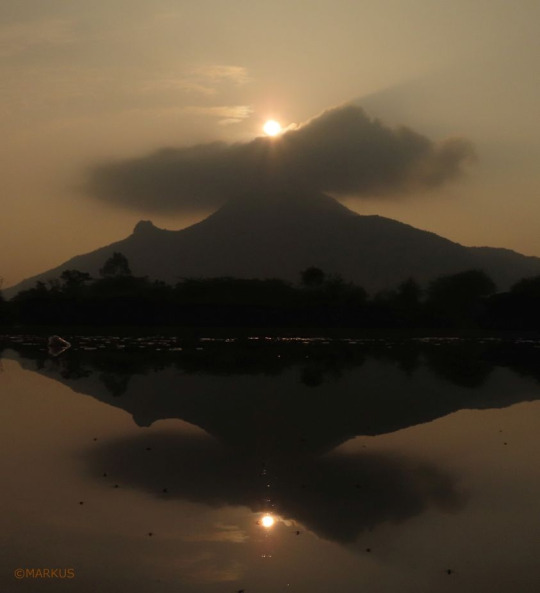
Arunachala - Photo by Markus Horlacher
#Bhagavan Sri Ramana Maharshi#Sri Arunachala Stuti Panchakam#Five Verses In Praise Of Arunachala#Arunachala Navamanimalai#AN v.1#The Necklace of Nine Gems for Arunachala#Chidambaram#Nataraja#cosmic dance#Arudra Darshanam#shakti#lord shiva#achala achalam#motionless immutable#achala devoid of thoughts#amala devoid of adjuncts#annihilation of the mind#nirmala pure#nischala motionless
27 notes
·
View notes
Text
Celebrating Makar Sankranti in India
Every year Makar Sankranti falls on the 14th or 15th of January, and there’s a good reason for that too. The term “Sankranti” refers to the movement of the Sun from one Zodiac to another, so there are a grand total of 12 Sankrantis. What makes Makar Sankranti special? During Makar Sankranti, the Sun moves from Sagittarius or Dhanu Rashi to Capricorn or Makar Rashi, in numerous ways this signifies a new beginning. The Sun which moves into the Northern Hemisphere leads to longer days and the end of the Indian Winter. It falls during the harvest season, with freshly cut crops offered to gods and subsequently eaten. The period signifies “fertility” and bursting into action after the slow and delirious winter season. It ushers in the “auspicious” part of the year which lasts until Karkata Sankranti which falls somewhere in July. It is also the only festival celebrated going by the solar calendar. The contrast between the cozy western holiday season and the vibrant onset of Hindu fertility is an abrupt transition but goes perfectly with the hopeful nature of the new year.
All over India, Makar Sankranti is celebrated in different ways with each one doing their own thing. 14th/15th January signifies not one or two but many festivals.
In Tamil Nadu, the festival is known as Pongal, which translates to “to boil, overflow” and freshly cut rice is cooked with milk and jaggery. The Tamil version can be traced back to the Chola empire, so roughly around the 9th to 13th century. Spread over three days (and a lesser-known fourth day), each day has its own significance. The first day is known as Bhogi Pongal or Indran and focuses on cleaning the house, as each member dusts and scrubs until every surface is squeaky clean. The second day is called Thai Pongal or Surya Pongal and is the most important day, the Pongal is made and first offered to the gods, then the cattle, and only after that are the family members allowed to have it. The third day is spent grooming and worshipping the cattle.
Uttayaran in Gujarat can only be defined by one word, “vibrant”. Strewn across skies are kites that made for a tapestry. There is an industry revolving around this particular time of the year, as kite sales skyrocket (pun intended) and officials from different countries come to participate in kite competitions. The reason behind flying kites is that being out in the Sun after the winter helps kill germs and be more exposed to Vitamin D. Dishes like Undhiyo that are nearing the end of their season are relished for the last time.
If we go farther North, we come across Lohri, the Punjabi variant of Makar Sankranti. The folklore attached to Lohri is of a man known as Dulla Bhat, who lived during the reign of Emperor Akbar. He used to steal from the rich and distribute it among the poor. In his honor, people sing “Sundar Mundriye” during Lohri. This story is different than the religious and godly myths surrounding the other festivals, and it’s fascinating how a festival honors a man who worked for the needy. Punjab is a largely agrarian state, so the festivities are rooted in harvesting crops. People get together around huge bonfires and eat everything from Chikki to Saro ka Saag.
There are tons of other festivals on this day, in Assam it's called Magh Bihu with games like tekeli-bhonga (pot-breaking) and buffalo fighting taking place. In Bihar, locals have chuda-dahi (beaten rice and yogurt) and a portion of gur (jaggery), and in Bengal, it’s called Poush Sankranti and have sweets like pithe, patishapta, etc. with rice and palm jaggery.
- Priyanshu

Painting Credits: Ladies on a Terrace Kite-fighting, circa 1775.
#india#indian#indian dark academia#indian aesthetic#aesthetic#dark academia#indian culture#desi#desi dark academia#makar sankranti#kites#kite flying#kite festival#pongal#magh bihu#uttarayan#Gujarat#Assam#Punjab#tamil Nadu#lohri#indian festival#indian festivals#festival#festivals
22 notes
·
View notes